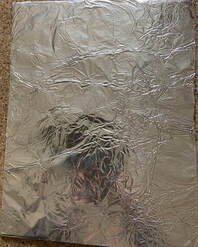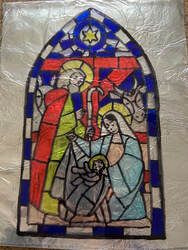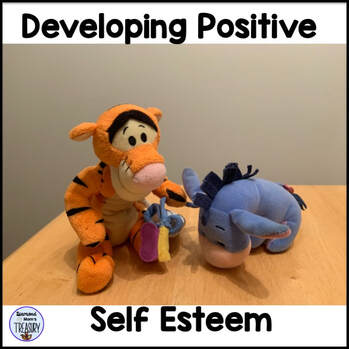The image below is the original one. You can still follow the directions here, but you may need to make slight changes to the procedure and materials used as explained below. The first step is to find an image that you would like to use. I chose this one because it is typical of what one might find when thinking of stained glass at Christmas time. You can choose anything you want. Color by code pictures or mandalas would work well. This is a coloring picture from Miss Mindy. Once you choose your image, it is necessary to transfer the image onto a transparent material. This time I used a laminating pouch. I placed the printed image (image 1) behind the pouch and opened up the pouch to trace the image on the inside surface. (images 2 and 3) Note: It is important to put it inside if you are going to laminate it so that you don't have the marker ink damaging your machine. If you have access to the transparency sheets used in the original version, it makes it easier because the image can be photocopied on to the transparency. This saves the tracing step. If not, I would suggest making sure the design is not too difficult for children to trace. Note: It is important to talk to them about how to trace without smudging the design. I usually suggest they start at the top and work their way down on the side opposite to the hand they are coloring with. Once you have the design traced, you can place a paper beneath the laminating pouch again so the areas can be seen as you add color. (image 5) I chose to change up the colors a bit so that they popped more. When you have finished coloring all the spaces desired, put the pouch through the laminator to seal it. (image 6) Note: I use a personal laminator with pouches. If you are using a different type of laminator this may not work. Another option could be to cut the laminating pouch apart and treat it like the transparency sheet. You would still need to trace the design because it can't be put in the photocopier. If the design is traced with a permanent marker ahead of time, it will be easier for use by everyone and it shouldn't smudge when the children color it. Note: The children should color the back of the transparency sheet or laminating sheet so that the washable markers won't smudge or wash off when it is placed on the tin foil. Next, prepare the background by cutting a piece of card stock or a cereal box to the correct size and covering it with tinfoil. I usually tape the tinfoil on the other side and then add a piece of writing on that side to hide the seams. My students preferred the crinkly foil as it caused the light to bounce off of the colors. (Sorry for all the shadows. I couldn't seem to find an angle where they weren't showing.) Finally, tape the transparent picture to the tinfoil card stock. Add the writing on the back and you are done. If you wish to hang it, punch some holes on the top and add some ribbon. If you would like a sampler copy of the writing templates click the image or here. I would love to hear how you use this idea in your classroom. If you have any other suggestions to make it easier please share in the comments below. Related Posts
0 Comments
Positive self esteem is so important when developing self confidence and a positive outlook on the world. Many people are living in situations that could lead to feeling negative or not valued. It is our job as teachers to help them see that they are valued and important and that they have much to contribute to the world around them. Environment is not the only thing that can impact self esteem. Some people have many opportunities and resources available to them, but they don't see them in a positive light. We need to help them see that they have much to be thankful for and show them ways that they can be optimistic instead of pessimistic about their lives. This is an ongoing thing that we need to work on. These are two reminders for me that hang on the wall of my office at home. Nobody knows what is going on in the thoughts and lives of others. We must try to help everyone to see that they are valuable members of our communities, classrooms, and families. Changing attitudes makes a world of difference. Attitude Is Everything Years ago I read a book about attitude being everything. That stuck with me. I even have a hat that says the same thing on it. I remember that being a motto that I took into my classroom and shared with my students. I began teaching lessons on optimism to them and I spent a great deal of time my first few weeks of school focusing on self esteem and acts of kindness. It was amazing to see how it transformed the atmosphere of my classroom. Tigger and Eeyore were a great resource for teaching the difference between the two attitudes. Although Eeyore is a lovable creature, he see the world in a pessimistic way and finds it hard to find joy. Tigger, on the other hand is full of optimism and sees joy in most everything. We don't have to be bouncing off the walls to have a positive outlook on the world, but it is important to see the joy instead of all the negatives. I created some task cards to help my students to think about how they could react either as an optimist or a pessimist in situations. We then discussed how that could change the way the day went. As they began to see the positive changes that could result, they started to look at life in a more positive manner. I created these in 3 different themes so that they could be used in a variety of situations depending on who was using them. You can check the others out here. I would like to give a free set of the smiles/frown edition to any of my email subscribers. If you are not one yet, you can click the button below to subscribe and get your free copy. For those who are already subscribers, you can access your copy on the free resources page above. Thank you for stopping by. If you have any suggestions, I would love to hear them. I hope you have a positive year.
It was 40 years ago that Terry Fox began the Marathon of Hope Run. This run continued after Terry died in 1981 as a tribute to what he had started and it has raised so much money for cancer research. Here is a repeat of a blog post from 2 years ago. I feel very strongly about this, so I felt it was important to bring it to the forefront again. The Marathon of Hope began many years ago when Terry Fox was a young man. He lost his leg to bone cancer when he was 18 years old. On April 12, 1980 he started his Marathon of Hope for cancer research. He was determined to run across Canada and raise $1.00 for every Canadian. He began his run on the east coast by dipping his foot in the Atlantic Ocean. Terry ran every day for about 42 km (26 miles). Imagine running a marathon distance every day. This is hard enough for someone with two strong legs, but Terry did it with a prosthesis on his one leg. He did this for 143 days. Terry Fox was unable to finish his Marathon of Hope. On September 1, 1980 he had to stop because cancer appeared in his lungs. He returned to his home and began treatment for the cancer. He was determined to continue fighting. On June 28,1981 his battle ended. He was no longer with us, but his legacy continues on. Every September cities across Canada and worldwide run in Terry's memory to continue his Marathon of Hope. Click here to find out more about Terry Fox and his Marathon of Hope. Here are some free activities to use with your students if you do a Terry Fox run in your area. I know it is very important in our schools and children still learn about our Canadian hero. Click on the image above to get your copy.
Using glyphs for math activities is engaging and very useful when teaching about data. Glyphs are not just pictures. They give informative data about a variety of topics. One picture can provide insight and data for comparing, classifying and counting activities. This can be a great way for sharing details about individuals anonymously as well. I used glyphs often in my class throughout the years. It was especially fun to use them when preparing for student led conferences. Sometimes I did activities that were interactive with the child and parents. Then we would look at the glyphs later as a class and work with the data. I found using glyphs to be valuable when sharing details about my students anonymously with others. Nobody knew who created the glyphs, but there was lots of information on each of them. These baby blocks were done during one of my conferences. The kids were excited to learn about themselves as babies and it was fun to make comparisons as a class the following day. Back to school is a great time to introduce glyphs. Bookmarks and name plates can be glyphs. All about me activities can also be done with glyphs. Here is one that I created that might be fun to try at the beginning of the school year, especially when we are possibly using more technology than usual right now. Glyphs can be seasonal as well. I like to do one with pumpkins in the fall, turkeys around Thanksgiving, and snowmen in the winter. These are just a few suggestions. There are so many different topics that can be used. Creating the glyphs can be fun, but in order to really appreciate their value, it is important to see what data they provide. Sometimes I ask the children to come up with the questions that could be asked, other times, I will provide a list of questions and we will find the answers together. Here are some sample questions that might fit different symbols and what they represent. Here is a blank form that I would use when generating questions with my students. I sort the questions out into 3 categories: counting, classifying, and comparing. These different categories provide so much information. The children are always amazed at how much a simple picture can tell. These are all included in my Steps and Templates For Creating Glyphs. Sign up for Diamond Mom's Treasury email list and get your free copy. You should really give it a try. I am sure your students will be amazed at some of the information they learn through this activity. Subscribers have access to all products on my free resources page. Don't wait, sign up now and get your free resources. Related Posts
|
About Me Charlene Sequeira
I am a wife, mother of 4, grandmother of 9, and a retired primary and music teacher. I love working with kids and continue to volunteer at school and teach ukulele. Categories
All
|












































 RSS Feed
RSS Feed